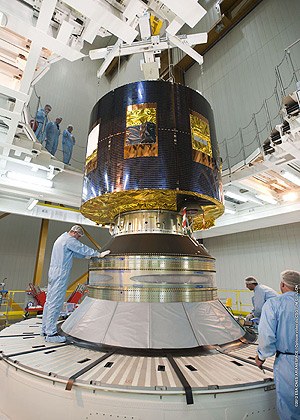Ariane 5 ready for launch in Kourou carrying one weather and one telecommunications satellite
VA207 carries both a commercial and an institutional payload on board. Both payloads will be placed in geostationary transfer orbits.
The European Organisation for the Exploitation of Meteorological Satellites (EUMETSAT) MSG-3 weather satellite is designed to supply European weather services with weather data from its orbital position at 0 degrees east. MSG-3, which will be referred to as Meteosat-10 following a successful launch, is carrying the Spinning Enhanced Visible and Infrared Imager (SEVERI) and Geostationary Earth Radiation Budget (GERB-3) instruments.

SEVIRI is the satellite's centrepiece and main instrument. It is an imager (optical observation device) that supplies data about Earth in 12 spectral bands. GERB-3 is a radiometer designed to make accurate measurements of Earth's radiation budget. The EUMETSAT meteorological programme is carried out in collaboration with the European Space Agency (ESA). EUMETSAT is responsible for the entire system, the requirements and the operation of the satellites, whereas ESA is responsible for developing and building the satellites. MSG-3 is the ninth satellite in the Meteosat series to be orbited by an Ariane launcher. Meteosat-1 had to be launched on a Delta rocket in 1977, because a European launch vehicle was not available at that time, but Meteosat-2 was the payload on the third Ariane flight in June 1981. Since then, every other Meteosat has also been launched on an Ariane vehicle.
The commercial payload on the flight is EchoStar XVII, a telecommunications satellite designed to provide broadband Internet connectivity across the United States for Internet provider Hughes Network Systems, taken over by EchoStar in 2011. The satellite, named Jupiter-1 before Hughes was taken over by EchoStar, is based on the LS 1300 bus from US satellite manufacturer Space Systems/Loral. EchoStar XVII is only the second EchoStar satellite to be launched on an Ariane. An Ariane 4 previously delivered EchoStar II into Earth orbit in September 1996.
Tags:
